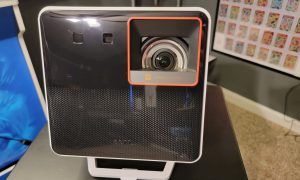I think I’ve had a good laptop sampling pool — better than most I’d argue. I’ve recently owned high-end offerings from MSI, OriginPC, Microsoft, and Dell. I now get to round that list out with what seems to be the most sleek and powerful combination of hardware and design elegance — the Razer Blade 15. Reading the list of specifications on the device, it seems impossible that all of it could fit in such a slim profile. Could this laptop finally live up to the full-powered gaming-on-the-go promise made by so many?
There are a number of Razer Blade 15 model configurations available, but they ultimately fall into two categories — base and advanced. Within each subcategory, are options like higher screen resolutions, touch capability, higher refresh rates, a more powerful GPU, storage variance, and the usual configuration options. Before we dig into the specifics of this particular configuration, and the benchmarks you all came for, let’s first look at what these Blade devices have in common.
Construction:
One of the best features of the Razer Blade 15 is the gorgeous black, near-unibody CNC aluminum black chassis that makes up the armor of the device. Unlike the oil-attracting rubberized surfaces, or the hard plastic shell of other laptops, the lightweight metal construction is light, durable, inflexible, and sturdy. It wipes away dust and fingerprints easily, resists scratches, and looks damned sexy. It’s also ice cold to the touch at idle, just as an added bit of fun. Dead center lies the signature Razer logo that glows when the case is open.
Connecting the case to the body is a nearly full-length hinge that attaches recessed at the rear of the chassis. This keeps the device safer and more sturdy than most laptops as the monitor isn’t “on stilts” and hanging away from the rest of the body. The Razer 14 had a more rounded beveled edge. Here we see rounded edges, but a more utilitarian and squared off appearance. It creates a industrial looking profile, and I have to admit…I kinda love it. It looks less like it was built as a consumer “thing of beauty” and more like a no-nonsense purpose-built device.
Headed inside, we get our fingers onto the anti-ghosting keyboard. Naturally, Razer has fully integrated their Chroma backlighting technology into the device, offering up 16.8 million color combinations, as well as full integration with Phillips Hue room lighting technologies, courtesy of the Razer Synapse software. Underneath lies a generously-sized Microsoft Precision trackpad with a glass surface, and that moniker isn’t an advertising gimmick. By implementing a Microsoft Precision trackpad, it is certified to have four finger gesture controls, pinch-to-zoom, rotation, tapping, clicking, and more direct and precise control via the touchpad. Better still, it’s providing a path for future improvements — something Microsoft has delivered on repeatedly through updates to Windows 10.
I’d be remiss if I didn’t mention one of my favorite, but often overlooked, features for any device with a tail — braided cables. The Razer Blade 15 uses a proprietary power cable with a 90 degree off-angle connector to keep it free of anything you might plug into the USB 3.0 ports. The power connector has a rubber boot over the omnidirectional connector, but the entire cable is wrapped in a sturdy braided covering that prevents it from tangling, and most importantly, fraying and splitting. As I throw away yet another mouse with a frayed end, I implore every manufacturer to stop shipping cables without protection.

Above? Awesomeness. Below? What happens when you don’t wrap your cables.
Cooling:
To keep the Razer Blade 15 running cool, the team adopted a small, vacuum-sealed, copper sealed vapor chamber cooling design flanked by two fans over a pair of heat exchangers, each with 68 0.1mm fins. It’s an incredible engineering feat and keeps the laptop running relatively cool. How cool varied wildly with the intensity of the game, but it tended to hover around the 82-84 degrees Celsius, which is consistently 10 degrees cooler than the sorts of temperatures I see out of my OriginPC EON-15, or my MSI G40 laptop, both of which use traditional heat pipe configurations.
My only complaint with the cooling is that the fans make a bit of a racket. The pair of 44-blade fans spin up as the temperatures begin to rise, as you would expect, but the fan and vapor chamber combination are running overtime to keep this device cool. At idle, the Razer Blade’s aluminum unibody case is very cold to the touch, and it doesn’t make any sound whatsoever. Throw something like Battlefield V at it, however, and you’ll find the device venting heat like a Marauder II mech on a geothermal desert biome. Dorky Battletech jokes aside, the speakers do a nice job of drowning out the spun up fans, but we’ll get to those in a moment.

These little guys work overtime to keep this ultra-thin cool.
Over extended gaming sessions, I couldn’t help but notice that, just like my OriginPC, the preponderance of heat seems to settle in the primary use space for shooters — the WASD keys, and to the left of the touchpad where you rest your palm. Those spaces don’t reach an uncomfortable heat level, but a quick check underneath the device was a reminder that “laptop” is a bit of a misnomer. Using an infrared temperature gun, I found that the surfaces near the rear of the case were hovering around 122 °F. Thankfully, that’s well within the tolerances of modern gaming devices, so there’s little to worry about, but there is no scenario where that’s going on my lap.
Speakers:
By eliminating the 10-key portion of the keyboard, Razer has given themselves space to integrate a solid set of speakers into the Razer Blade 15. Flanking the keys on both sides, and hiding behind mesh speaker grills, are Dolby Atmos 2.0 speakers. These deliver a nice crisp sound, at a volume that should serve any portable need you might have. I was happy to hear a little more bass than I get from my other devices, which is welcome in bombastic action movies and shooters. Like most laptop speakers, these get the job done, and they will easily drown out the sound of the fans, but packing a pair of decent headphones is always going to be a better option.

The speakers flank your fingers aside the keyboard.
Size:
Razer claims that this device is the smallest 15” gaming laptop, but that really doesn’t tell the whole story. The base model is just 0.78” tall (that’s marginally taller than a dime, for reference), 9.25” from keyboard edge to folding edge of the monitor, and 13.98” from width edge to edge. The advanced model gets put on a strict diet, shrinking the height down to 0.68”, with the other two dimensions remaining the same.
In terms of weight, the base model weighs 4.48 lbs, with the 180 watt power supply adding an additional 1.3 lbs to the overall heft. The advanced model, despite being slightly slimmer, is more dense at 4.73 lbs, but the larger 230 watt power brick pushes the weight an additional 1.7 lbs. Compared, as an example, to my MSI laptop at nearly 4x the weight, I had to laugh at just how ludicrously light the Razer Blade 15 is, given the power it delivers.

The Razer lives up to its name.
Ports:
The Razer team thought long and hard about what ports to put on this device, and it shows. They put the aforementioned omnidirectional braided power port on the side of the device instead of the rear, keeping that rear hinge free of any apertures that would cause a need to make it larger. Next to the power port lies two USB 3.0 connections and an audio jack. On the right side lies a third USB 3.0 connection, flanked by an HDMI 2.0 port, a USB-C Thunderbolt 3 port, and a Mini-DisplayPort 1.4 connector. To keep everything safe, there’s also a Kensington Security Slot to allow you to lock your laptop to your desk with an appropriate cable.
Between the base model and the advanced version lies one significant difference. By slimming the device further to get to the advanced model, Razer also eliminated the integrated Gigabit Ethernet Jack. This may or may not affect your use case, but it’s something worth noting.
Storage:
There is one other thing that feels somewhat slim — storage. The included Samsung M.2 PCIe drive is a whiteboxed 960 EVO. I utilize a 1TB version of this drive myself, but that means taking out the one included with the Blade and replacing it as there is no second M.2 slot. The thinner profile doesn’t support a 2.5” hard disk drive for mass storage, not that you’d want the additional weight. It’d just be nice to have a little more space as games like Middle-earth: Shadow of War will soak up 97.7GB — a full fifth of your total space. .
Specifications:
As I’ve mentioned, there are several configuration options to choose from. Here are the specifics on the Razer Blade 15 I reviewed:
- 8th-gen 6-core Intel Core i7-8750H
- 16GB of DDR4/2677 in dual-channel mode
- NVIDIA GeForce GTX 1070 Max-Q
- 512GB Samsung M.2 PCIe SSD
- 15.6-inch, 1920×1080 resolution, 144Hz refresh rate
Monitor:
The monitor on the Razor Blade 15 model I tested is the 15.6” 1080p version with the buttery-smooth 144Hz refresh rate. I use a full-size 144Hz monitor for gaming, and a standard 60Hz for my daily writing and work, so I can easily see the visible difference. Combined with a near bezel-less construction (the bezels are just 4.9mm), the screen is bright, incredibly responsive, viewable from any angle, and one of the clearest displays I’ve ever seen on a portable platform. It’s nice to see a company refuse to compromise.
Given how much emphasis has been placed on HDR lately, I was surprised to see that the Razer Blade 15 doesn’t support it. Still, given how little adoption that technology has received at this point, I can easily concede that to the next generation of hardware in favor of the cleaner and more vibrant display that Razer has brought to the table with this latest device.
Despite the incredibly tiny bezel, Razer must have gotten tired of looking up people’s noses during game streams and moved their camera back to the top edge of the monitor, where it belongs. At the top center of the display lies an integrated 720p camera, providing a straight-on image of my face, rather than a ground-up look at my nose hairs.

This monitor is absolutely beautiful, and the viewing angles are INSANE!
Battery Life:
Once again we see a slight difference between the base and advanced model of the Razer Blade 15 in terms of battery power. The base sports a 65Wh battery with an advertised 6 hours of life, and the advanced pushes that up to 80Wh, though the additional power still holds the battery expectation to 6 hours. Gaming naturally can create a great deal of variance in battery life depending on the intensity of the game in question, but to test consistent battery drain I wanted to use something more predictable. As such, I fired up a digital copy of Blade Runner 2049 and let it run. Surprisingly, Razer was being conservative with their estimates. At six hours and 43 minutes the battery tapped out and died the first test, and then after a full charge the battery nodded off at 6 hours and 47 minutes.
Virtual reality:
If you’ve been reading the site for any length of time, you know I’m a VR junkie. While my other laptop samplings have the capability to run VR, framerate is often an issue which can lead to nausea. Here, the GeForce 1070 Max-Q is more than capable of delivering rock solid framerates to either VR platform without batting an eye. Coupled with the ease of setting up the Oculus Rift, you suddenly have a portable virtual reality rig. Rather than running separate benchmarks for VR, I’ll simply say that it works and I can’t tell any perceivable difference at base settings. Pushing the supersampling rate will push the hardware harder, but that’s to be expected. Let’s dig into what that “Max-Q” moniker means to help explain how that might impact performance.
What is Max-Q?
The GeForce 1070 is a powerful card, and well past the line of recommended spec for both current VR headsets. This particular device sports a 1070 Max-Q, so it’s worth digging into what that second designation means. First and foremost, Max-Q is simply a specification that NVIDIA has built around the 1060, 1070, and 1080 line of cards to make them slim, power efficient, and heat tolerant. Thankfully, these are built with power in mind, so it’s also very easy to figure out where they fit in the pantheon of cards. In short, they’ll run right about where the desktop equivalent one notch below would fit. A 1070 Max-Q, in this case, will turn out about 20-25% less frames per second, placing it just above what a desktop 1060 can do. As a result, the game will run pretty much anything under the sun at 1080p, and will hit somewhere between 60 and the 144 fps max that matches the silky-smooth native monitor refresh rate. That makes it more than capable of delivering the 90fps necessary for VR games on the market today.
Benchmarking:
If you are looking for a ton of synthetic benchmarks, I’m certain there are a number of sites who will regale you with pretty graphs that mean very little. No, fair reader, you are here to see how this device handles gaming because we are gamers. So, let’s game.
I picked a handful of familiar games that will push both the CPU and GPU hardware to the edge. Shadow of the Tomb Raider, Assassin’s Creed Odyssey, Far Cry 5, Ashes of the Singularity, and Battlefield V. It’s a good cross-section of DX11 and DX12 titles, with a variety of push and pull on hardware, memory, CPU, and graphical processing capabilities without leaning on any one too excessively. It also represents a mix of mature games that have seen several revisions, as well as games that have just came out and could still see driver refinement and patches to improve performance. All tests were run at their highest settings, and at 1080p and with the newest drivers at the time of this writing — NVIDIA’s 416.81 Game Ready drivers. Without further ado, let’s see some benchmarks!
Ashes of the Singularity – GPU Focused / CPU Focused tests
This title will eat your GPU for lunch and ask for seconds, literally — it’s one of the few that properly supports graphics cards in SLI. It’s capable of crushing most video cards with the number of high-detail objects on the screen, the visual fidelity, and the effects on each. As you can see in the benchmark results for the GPU and CPU focused tests, there is a hell of a lot of data coming from the test. The Oxide Engine is capable of delivering a lot of data beyond a static “average framerate”. Rather than trying to re-explain how you might interpret all of this great crunchy information, I’ll let the Oxide team do it directly.
Loosely interpreted, the laptop delivers on all fronts, able to handle the myriad of objects and all of the awesome effects attached to each in stride. The framerate is buttery smooth at 1080p at the highest detail levels. While I have sincere doubts it could handle the same test so elegantly at 4K, there’s no doubt it’s a runner at this resolution.
Assassin’s Creed Odyssey
Most Ubisoft games today supports an adaptive framerate setting, but I wanted to see what this laptop could do with and without it. The first test comes in at a gorgeous, but sub-target 44fps average. Using adaptive framerate pushes the framerate up to 48. Odyssey is a fairly demanding game, and it’s also very GPU-dependent. My 1080Ti can hit the vaunted 60fps mark, but I wouldn’t expect a mobile platform to match. Still — hitting 48fps on the go is nothing to sneeze at.
Far Cry 5
Replacing Far Cry Primal as my go-to test platform, Far Cry 5 is a good stress test with a variety of explosions, outdoor environments, and detail There’s only one test, as you’ll see below, as there wasn’t a need to turn on adaptive framerate and run it again. The Razer Blade 15, at highest detail settings, and at 1080p, turned out a eye-popping 70fps average for Ubisoft’s open world cult-sim.
Shadow of the Tomb Raider
Square Enix’s newest title is one of only two titles on the market capable of delivering RTX visuals at the time of writing. With bleeding edge graphics, it’ll push down most PCs, kick ‘em in the ribs, and take their lunch money. With SMAA4X turned on, and even without RTX, it makes my 1080Ti desktop graphics card whimper a bit, at least at 4K resolution. As you can see in the video below, the card is more than capable, even with SMAA4X of delivering an average of 51fps — solid scores for the 1080p crowd.
Turning down the anti-aliasing to TAA has very little visual effect on the game, but makes a significant impact on the overall framerate. Coming across the line at an average of 69fps, it’s well across the line for maintaining the smoothest framerate possible. YouTube will undoubtedly mangle it, but see for yourself in the video below:
Battlefield V
The latest iteration on the Battlefield formula doesn’t have a formal benchmarking utility, but playing fairly consistently the last few weeks with benchmarking utilities running, I can say that the Razer Blade 15 is delivering between 55 and 65 fps on most maps, with recent driver improvements pushing closer to the 60 mark. New drivers hit just as I started writing this review, so I can expect further nudges towards the objective of 1080p/60.
Pricing:
Value judgements are difficult when it comes to hardware. If you travel and want to be able to bring something better than your phone to play, then it’s hard to argue with bringing desktop-level power with you on your trip. If you rarely travel, then you may appreciate the ability to hook this device up to the Razer Core V2 when you are home to be able to upgrade your video card in the future. The base model, with a GeForce 1060, 1TB hard drive coupled with an SSD, and a 60Hz refresh rate monitor will run you $1599 — a recent price drop for that model from the previous $1899 price point. Jumping up to the 1070 with the 144Hz monitor, pure SSD, and as configured for this review, will pop that price up to $2399. With most of our benchmarking hitting around 60fps, I could see saving a few dollars, sticking with the 1060 model, and picking up the aforementioned Core V2 to put whatever videocard your heart desires in the future for when you are gaming at home. But hey — it’s your money, and I’m not your dad.
Ron Burke is the Editor in Chief for Gaming Trend. Currently living in Fort Worth, Texas, Ron is an old-school gamer who enjoys CRPGs, action/adventure, platformers, music games, and has recently gotten into tabletop gaming.
Ron is also a fourth degree black belt, with a Master's rank in Matsumura Seito Shōrin-ryū, Moo Duk Kwan Tang Soo Do, Universal Tang Soo Do Alliance, and International Tang Soo Do Federation. He also holds ranks in several other styles in his search to be a well-rounded fighter.
Ron has been married to Gaming Trend Editor, Laura Burke, for 28 years. They have three dogs - Pazuzu (Irish Terrier), Atë, and Calliope (both Australian Kelpie/Pit Bull mixes), and an Axolotl named Dagon!

The Razer Blade 15 delivers staggering power in an impossibly small package. Able to handle any modern game on the market without compromise, this is what desktop power on the go looks like. Just know that you get what you pay for...and this sort of performance doesn’t come cheap.
PROS
- 1080p/60 on nearly everything tested
- Impossibly small and elegant form factor
- VR-capable laptop
- Display is gorgeous
- Solid battery life
CONS
- 512GB of storage feels too small
- Runs a little hotter and louder than I’d hoped
See below for our list of partners and affiliates:

























